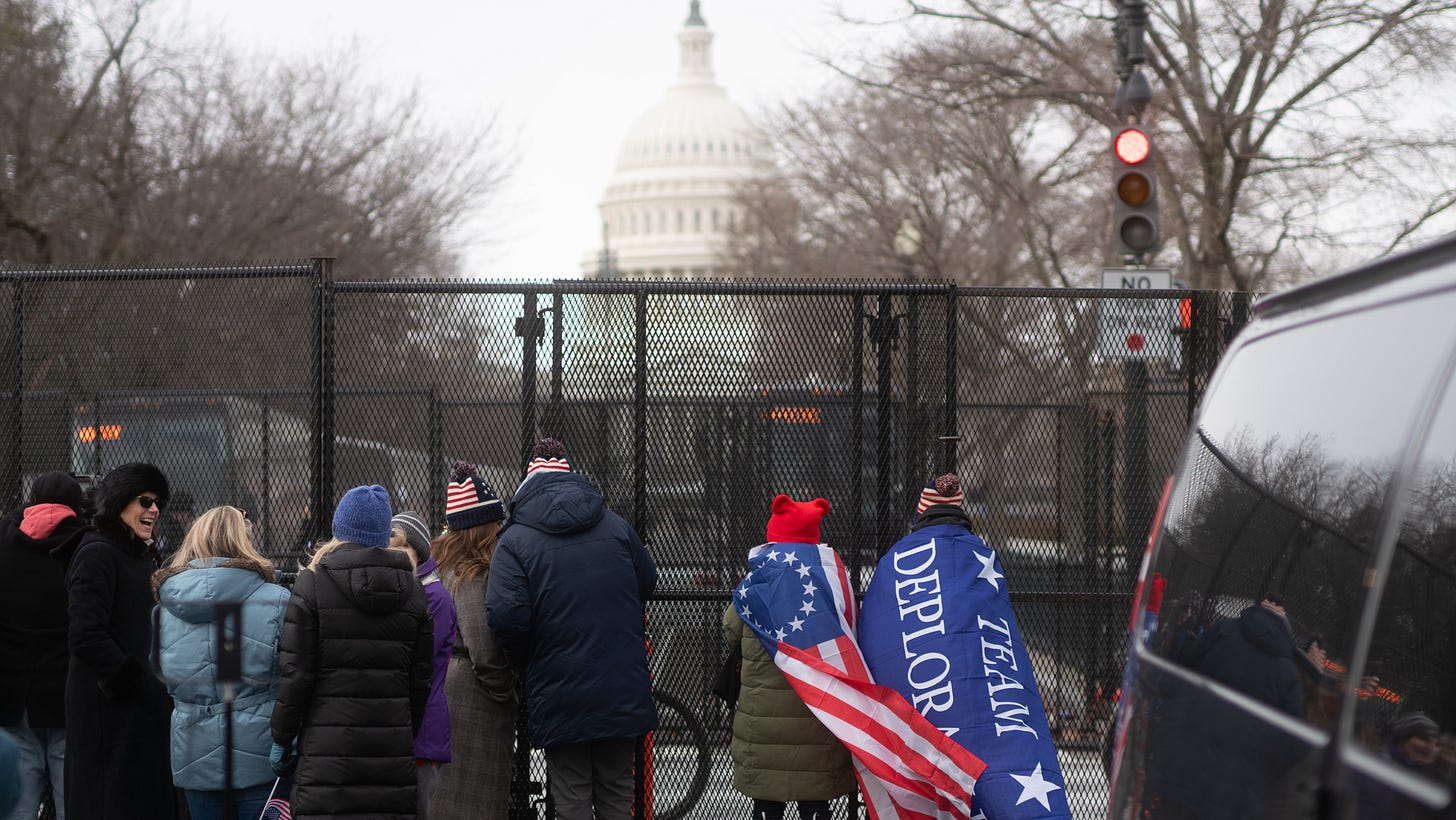Trump's return isn't met with equal and opposite force
How to cover the new administration, lessons from the Nixon administration, and the same old Philadelphia story.
It’s a bitter cold week in Washington. Ice is covering the Potomac and the average temperatures are hovering around former Rep. Matt Gaetz’s Tinder age range. The frigid weather forced most of the inaugural festivities inside Monday and set us journalists scrambling to plan around the change of venue.
We did the best we could, and I’m proud of the National Journal team for our full court press covering the inauguration of the 47th president. President Trump made enough news in his first 24-hours in office to fill up a dozen reporters’ notebooks (more on that below) and we’re still sorting through it all. I’m particularly proud of this landscape piece from our team taking in the scene from three different venues and for pictures my brother Chandler, visiting from New York, took of the historic day.
I bounced around a few different GOP watch parties along Capitol Hill on Monday, taking in the scene with the Trump faithful. I spent the most time at Tune Inn, a dive within spitting distance of the Capitol that I’ve spent a lot of time and treasure. It was standing room only and quite a different crowd than the usual scene of staffers and reporters jockeying for the Touch Tunes. This crowd cheered for the right figures, booed President Obama, and one guy wearing an American flag yelled that he was keeping track of everyone not clapping for Trump when he flashed on the screen.
I think he was joking, but you can never be too sure.
It’s a brave new world in Washington that feels oddly similar to 2017. The only thing missing was a forceful resistance. Thousands of demonstrators descended on Washington the day after Trump’s first inauguration for the Women’s March, protesting what they saw as an affront to decency as a man credibly accused of sexual misconduct entered the White House. This year it was crickets. Maybe the cold keep the resisters inside, but that silence was louder than any MAGA cheer I heard over the weekend.
What’s the lead, Don?
First appeared in National Journal on Jan. 22.
President Trump might have opened a new front in the war against the media by repeatedly calling the press “the enemy of the people” in his first term, but President Nixon helped pave the way for this mistreatment 50 years ago.
The Boys on the Bus, while primarily known for its unsparing examination of the journalists covering the 1972 presidential campaign, also details the very particular machinations of the White House press corps under Nixon.
Author Timothy Crouse, a reporter for Rolling Stone, wrote that Nixon’s press office took advantage of long-established norms of the White House press corps to avoid accountability. The quarterback in Nixon’s offense against the press was Press Secretary Ron Ziegler, who “treated the press with a bland contempt that was quite genuine and unaffected.”
Ziegler would give the media “the old squeeze play,” as Crouse coined, shining a light on some journalists by allowing access or scoops, icing out reporters for perceived wrongs, and saving news until the final ticks before a print deadline in order to limit questions. Journalists craved the warmth of Ziegler’s sun and, in Crouse’s telling, would go out of their way to curry favor with a man who employed “divide and rule” tactics.
His press shop would also purposefully obfuscate. Crouse writes: “At the briefing lectern, he was smug, condescending, and relentlessly evasive, often refusing to answer the simplest and most innocuous of questions. He talked in a kind of flackspeak that would have given Orwell nightmares. … He reversed White House positions by the simple expedient of announcing that he had ‘misspoken’ himself in the past.”
As Trump returns to the office, there are plenty of parallels between the 47th and 37th presidents. Instead of misspeaking themselves, Trump’s spokespeople offer “alternative facts.” Trump’s communications team is also staffed with loyalists who make no qualms about barring certain reporters from the campaign trail, and reporters covering the White House fear the same “fire and fury” that plagued their reporting on the first term.
Unlike Nixon, however, Trump does not leave the media starving for news. In fact, the torrent of news he provides leaves reporters scrambling to keep up. Take his first few hours in office: he delivered what amounted to four inaugural addresses, signed a record number of day-one executive orders, pardoned nearly all the Jan. 6 convicts, challenged the 14th Amendment, withdrew from several international agreements, and threatened tariffs that could upend the stock market.
The flood of information from Trump recalls another anecdote from Boys on the Bus. When it came time to file stories after a day on the campaign trail, the younger reporters would turn to veteran AP correspondent Walter Mears for direction.
“What’s the lead, Walter?” the guys would ask to make sure they weren’t missing the news that was driving the day. The challenge today is that in any one day Trump could produce enough news to fill dozens of reporters’ notebooks. It’s now up to the fragmented members of the media, like us here at Hotline, to ask ourselves what’s the lead?
The President Who Came in from the Cold
First appeared in National Journal on Jan. 21.
President Trump’s return to the White House marked a triumphant return from exile for the man who looked dead in the water four years ago following the insurrection at the Capitol.
Trump was embraced warmly by official Washington, which has grown more open to his style and policies. Major fashion houses outfitted the first family after snubbing them eight years ago, the tech barons who banned Trump from their platforms were front-and-center as he took the oath of office, and President Biden gave the incoming first couple the trappings of a graceful transition of power that Trump denied Biden four years ago.
“Welcome home,” the outgoing president told the man he once agreed was a fascist at the entrance to the White House.
If observers expected Trump to return the favor of civility and strike a new tone, they were as disappointed as they were naive. Trump’s 29-minute inaugural address might not have had a line as memorable as “American carnage” from his 2017 address, but his inaugural speech painted a bleak picture of the country he was inheriting. He previewed a “truculent attack on ‘a radical and corrupt establishment,’” as our own George E. Condon Jr. wrote, and repeatedly pummelled Biden’s policies with his predecessor sitting within arm’s reach.
The score settling did not end there. Within hours of taking the oath of office to uphold the Constitution in the Capitol Rotunda, Trump issued a sweeping pardon of the nearly 1,600 people charged for storming that very same building on Jan. 6, 2021. Trump’s decision undercut Vice President J.D. Vance, who just a week ago told Fox News Sunday that “if you committed violence on that day, obviously you shouldn’t be pardoned” when asked about potential Jan. 6 pardons.
For as much as Washington has changed in the last four years, Trump hasn’t. He has only become more emboldened to assert his will.
Face for the radio
On Monday I hosted our latest episode of National Journal Radio. I talked with our White House correspondent George E. Condon Jr. and senior national correspondent Zac Weisz about the inauguration and put President Trump’s return to the White House in historic context.
Quick takes
What’s old is new again! President Trump’s first week in office features a classic throwback to his first term.
It’s déjà vu all over again for Republican members of Congress after Trump’s first wave of executive actions. This week they’ll face questions from the diligent Capitol Hill press corps over Trump’s controversial actions yesterday like ending birthright citizenship and issuing a blanket pardon for nearly all 1,600 people charged in connection to Jan. 6. Expect members to offer some version of “I didn’t read the full order” as an excuse or for the more outspoken members like Sen. Susan Collins (R-ME) to express “concern” over the executive actions. Trump had four years in the wilderness to hone his use of executive power, but it doesn’t seem like his Republican colleagues took time to craft a better defense.
Reads that made me smarter
It’s hard to imagine a basketball franchise suffering a more miserable season than the 76ers. After “winning the offseason” by signing Paul George and extending stars Joel Embiid and Tyrese Maxey, Philadelphia are 15-27 and battling for a play-in spot. Embiid has only played in 13 games and it seems like the locker room is broken. Zach Kram at The Ringer made a compelling case to shut down the former MVP and trust the tanking process. “The decision of whether to pursue wins or ping-pong balls should come down to more than simple draft pick probabilities."
My friend Bill Scher took another interesting look at media organizations not making the immense challenge of covering President Trump any easier on themselves with publication leaders bending the knee. Scher raised the alarm on three recent incidents at the New York Times, Politico, and the Wall Street Journal that amount to a troubling trend of subjection from the leaders of the biggest news organizations in the country.



